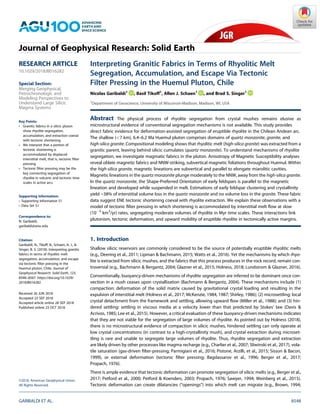Mais conteúdo relacionado Semelhante a Garibaldi et al 2018 (20) 1. Interpreting Granitic Fabrics in Terms of Rhyolitic Melt
Segregation, Accumulation, and Escape Via Tectonic
Filter Pressing in the Huemul Pluton, Chile
Nicolas Garibaldi1
, Basil Tikoff1
, Allen J. Schaen1
, and Brad S. Singer1
1
Department of Geoscience, University of Wisconsin-Madison, Madison, WI, USA
Abstract The physical process of rhyolite segregation from crystal mushes remains elusive as
microstructural evidence of conventional segregation mechanisms is not available. This study provides
direct fabric evidence for deformation-assisted segregation of eruptible rhyolite in the Chilean Andean arc.
The shallow (<7 km), 6.4–6.2 Ma Huemul pluton comprises domains of quartz monzonite, granite, and
high-silica granite. Compositional modeling shows that rhyolitic melt (high-silica granite) was extracted from a
granitic parent, leaving behind silicic cumulates (quartz monzonite). To understand mechanisms of rhyolite
segregation, we investigate magmatic fabrics in the pluton. Anisotropy of Magnetic Susceptibility analyses
reveal oblate magnetic fabrics and NNW-striking, subvertical magnetic foliations throughout Huemul. Within
the high-silica granite, magnetic lineations are subvertical and parallel to elongate miarolitic cavities.
Magnetic lineations in the quartz monzonite plunge moderately to the NNW, away from the high-silica granite.
In the quartz monzonite, the Shape-Preferred Orientation of early feldspars is parallel to the magnetic
lineation and developed while suspended in melt. Estimations of early feldspar clustering and crystallinity
yield ~38% of interstitial volume loss in the quartz monzonite and no volume loss in the granite. These fabric
data suggest ENE tectonic shortening coeval with rhyolite extraction. We explain these observations with a
model of tectonic filter pressing in which shortening is accommodated by interstitial melt flow at slow
(10À5
km3
/yr) rates, segregating moderate volumes of rhyolite in Myr time scales. These interactions link
plutonism, tectonic deformation, and upward mobility of eruptible rhyolite in tectonically active margins.
1. Introduction
Shallow silicic reservoirs are commonly considered to be the source of potentially eruptible rhyolitic melts
(e.g., Deering et al., 2011; Lipman & Bachmann, 2015; Watts et al., 2016). Yet the mechanisms by which rhyo-
lite is extracted from silicic mushes, and the fabrics that this process produces in the rock record, remain con-
troversial (e.g., Bachmann & Bergantz, 2004; Glazner et al., 2015; Holness, 2018; Lundstrom & Glazner, 2016).
Conventionally, buoyancy-driven mechanisms of rhyolite segregation are inferred to be dominant once con-
vection in a mush ceases upon crystallization (Bachmann & Bergantz, 2004). These mechanisms include (1)
compaction: deformation of the solid matrix caused by gravitational crystal loading and resulting in the
expulsion of interstitial melt (Holness et al., 2017; McKenzie, 1984, 1987; Shirley, 1986); (2) microsettling: local
crystal detachment from the framework and settling, allowing upward flow (Miller et al., 1988); and (3) hin-
dered settling: settling in viscous media at a velocity lower than that predicted by Stokes’ law (Davis &
Acrivos, 1985; Lee et al., 2015). However, a critical evaluation of these buoyancy-driven mechanisms indicates
that they are not viable for the segregation of large volumes of rhyolite. As pointed out by Holness (2018),
there is no microstructural evidence of compaction in silicic mushes, hindered settling can only operate at
low crystal concentrations (in contrast to a high-crystallinity mush), and crystal extraction during microset-
tling is rare and unable to segregate large volumes of rhyolite. Thus, rhyolite segregation and extraction
are likely driven by other processes like magma recharge (e.g., Charlier et al., 2007; Sliwinski et al., 2017), vola-
tile saturation (gas-driven filter-pressing; Parmigiani et al., 2016; Pistone, Arzilli, et al., 2015; Sisson & Bacon,
1999), or external deformation (tectonic filter pressing; Bagdassarov et al., 1996; Berger et al., 2017;
Propach, 1976).
There is ample evidence that tectonic deformation can promote segregation of silicic melts (e.g., Berger et al.,
2017; Petford et al., 2000; Petford & Koenders, 2003; Propach, 1976; Sawyer, 1994; Weinberg et al., 2015).
Tectonic deformation can create dilatancies (“openings”) into which melt can migrate (e.g., Brown, 1994;
GARIBALDI ET AL. 8548
Journal of Geophysical Research: Solid Earth
RESEARCH ARTICLE
10.1029/2018JB016282
Special Section:
Merging Geophysical,
Petrochronologic and
Modeling Perspectives to
Understand Large Silicic
Magma Systems
Key Points:
• Granitic fabrics in a silicic pluton
show rhyolite segregation,
accumulation, and extraction coeval
with tectonic shortening
• We interpret that a portion of
tectonic shortening is
accommodated by displaced
interstitial melt, that is, tectonic filter
pressing
• Tectonic filter pressing may be the
key connecting segregation of
rhyolite in volcanic and tectonic time
scales in active arcs
Supporting Information:
• Supporting Information S1
• Data Set S1
Correspondence to:
N. Garibaldi,
garibaldi@wisc.edu
Citation:
Garibaldi, N., Tikoff, B., Schaen, A. J., &
Singer, B. S. (2018). Interpreting granitic
fabrics in terms of rhyolitic melt
segregation, accumulation, and escape
via tectonic filter pressing in the
Huemul pluton, Chile. Journal of
Geophysical Research: Solid Earth, 123,
8548–8567. https://doi.org/10.1029/
2018JB016282
Received 26 JUN 2018
Accepted 23 SEP 2018
Accepted article online 28 SEP 2018
Published online 23 OCT 2018
©2018. American Geophysical Union.
All Rights Reserved.
